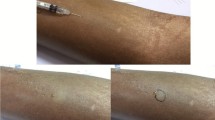Abstract
Recently, a possible etiological connection between infection with Borrelia burgdorferi and various skin lesions, including morphea and systemic sclerosis (SSc), has been discussed. The aim of our study was the evaluation of frequency of skin thickening typical of SSc or morphea in the group of patients with Lyme disease (LD) with frequent exposition to tick bites. The group consisted of 110 patients with LD frequently exposed to tick bites form the northeastern Poland, which is an endemic area for this disease. To measure the skin lesions, the modified Rodnan total skin score (RTSS) was used. In the analyzed group, no skin changes typical of morphea or skin thickening were found. According to RTSS, all patients scored 0 points. Raynaud’s phenomenon in all patients was not found. The relationship between scleroderma or morphea and LD is still a matter of controversy. Described by some authors, cases with LD and scleroderma may be associated with co-existence of B. burgdorferi infection with autoimmune process.
Similar content being viewed by others
References
Eisendle K, Grabner T, Zelger B (2007) Morphoea: a manifestation of infection with Borrelia species? Br J Dermatol 157(6):1189
Zulian F, Athreya BH, Laxer R et al (2006) Juvenile localized scleroderma: clinical and epidemiological features in 750 children. An international study. Rheumatology 45(5):614–620
Black CM (1993) Scleroderma-clinical aspects. J Intern Med 234:115
Scheja A, Akesson A (1997) Comparison of high frequency (20 MHz) ultrasound and palpation for the assessment of skin involvement in systemic sclerosis (scleroderma). Clin Exp Rheumatol 15:283
Hesselstrand R, Scheja A, Wildt M, Akesson A (2008) High-frequency ultrasound of skin involvement in systemic sclerosis reflects oedema, extension and severity in early disease. Rheumatology 47:84
Moreno C, Kutzner H, Palmedo G et al (2003) Interstitial granulomatous dermatitis with histiocytic pseudorosettes: a new histopathologic pattern in cutaneous borreliosis. Detection of Borrelia burgdorferi DNA sequences by a highly sensitive PCR-ELISA. J Am Acad Dermatol 48:376
Prinz JC, Kutasi Z, Weisenseel P, Poto L, Battyani Z, Guzicka T (2009) Borrelia-associated early-onset morphea: a particular type of scleroderma in childhood and adolescence with high titer antinuclear antibodies? Results of a cohort analysis and presentation of three cases. J Am Acad Dermatol 60:248–255
Grigor’eva LA, Babkin AV (1999) The use of a silver staining method in the diagnosis of the late skin lesions in ixodid tick-borne borreliosis in man. Parazitologia 33:267–269
Aberer E, Neumann R, Stanek G (1985) Is localized scleroderma a Borrelia infection? Lancet 2:278
Zollinger T, Mertz KD, Schmid M, Schmitt A, Pfaltz M, Kempf W (2010) Borrelia in granuloma annulare, morphea and lichen sclerosus: a PCR-based study and review of the literature. J Cutan Pathol 37(5):571–577
Mullegger MM (2004) Dermatological manifestations of Lyme borreliosis. Eur J Dermatol 14:296–309
Aberer E, Klade H, Stanek G (1991) Borrelia burgdorferi and different types of morphea. Dermatologica 182:145–154
Breier FH, Aberer E, Stanek G (1999) Isolation of Borrelia afzelii from circumscribed scleroderma. Br J Dermatol 140:925–930
Raguin G, Boisnic S, Souteyrand (1992) No evidence for a spirochetal origin of localized scleroderma. Br J Dermatol 127:218–220
Ranki A, Aavik E, Peterson P (1994) Successful amplification of DNA specific for Finish Borrelia burgdorferi isolates in erythema chronicum migrans but not in scleroderma lesions. J Invest Dermatol 102:339–345
Alonso-Llamazares J, Persing DH, Anda P (1997) No evidence for Borrelia burgdorferi infection in lesions of morphoea and lichen sclerosus et atrophicus in Spain. A prospective study and literature review. Acta Derm Venereol 77:299–304
Ozkan S, Atabey N, Fetil E (2000) Evidence for Borrelia burgdorferi in morphea and lichen sclerosus. Int J Dermatol 39:278–283
Fujiwara H, Fujiwara K, Hashimoto K (1997) Detection of Borrelia burgdorferi DNA (B. garinii or B. afzelii) in morphoea and lichen sclerosus et atrophicus tissues of German and Japanese but not of US patients. Arch Dermatol 133:41–44
Wackernagel A, Bergmann AR, Aberer E (2005) Acute exacerbation of systemic scleroderma in Borrelia burgdorferi infection. J Eur Acad Dermatol Venereol 19:93–96
Conflict of interest
All authors did not have a financial relationship with any organization that sponsored the research. The authors declare that they have no conflict of interest.
Author information
Authors and Affiliations
Corresponding author
Rights and permissions
About this article
Cite this article
Moniuszko, A., Gińdzieńska-Sieśkiewicz, E., Pancewicz, S.A. et al. Evaluation of skin thickness lesions in patients with Lyme disease measured by modified Rodnan total skin score. Rheumatol Int 32, 3189–3191 (2012). https://doi.org/10.1007/s00296-011-2157-7
Received:
Accepted:
Published:
Issue Date:
DOI: https://doi.org/10.1007/s00296-011-2157-7




